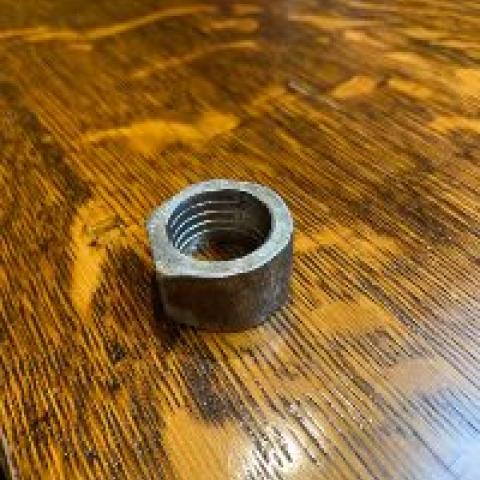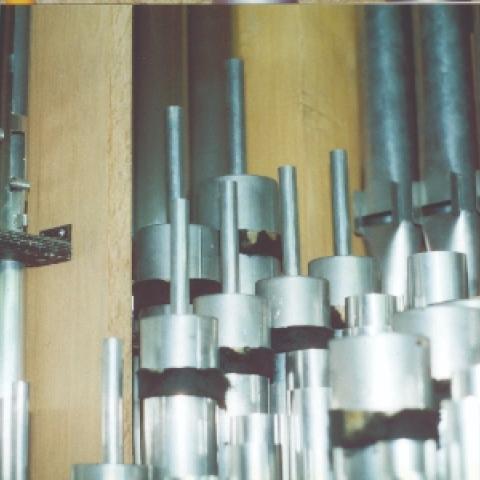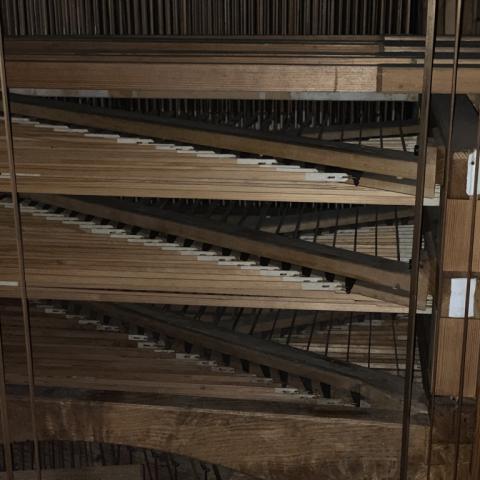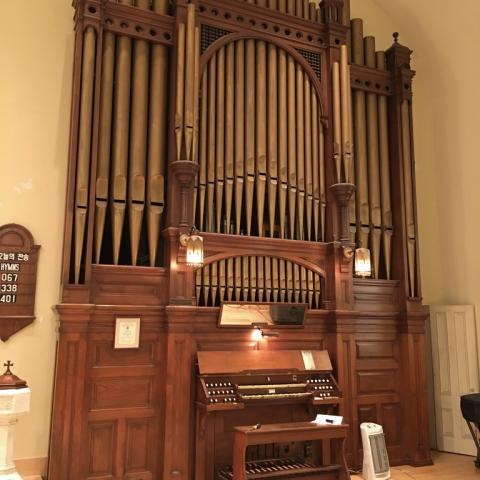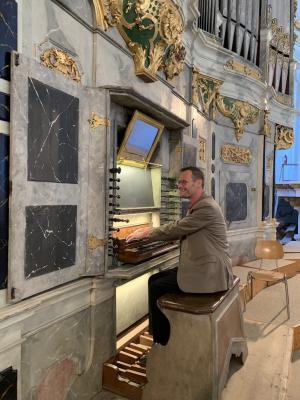
The beat goes on.
At Oberlin College, January is a month of independent study between the fall and spring semesters known as winter term. During the fall, students propose projects to their principal teachers for approval. Projects can be off campus, and sometimes they are vacations disguised as serious research. I do not remember much about some of my winter term projects, but winter term of 1977, my junior year, was special.
My organ teacher, Haskell Thomson, designed a project for me and about eight of my peers, inviting the legendary eurhythmics professor Inda Howland out of retirement to lead us in a month of rhythmic adventures. Swiss musician and educator Émile Jaques-Dalcroze (1865–1950) invented eurhythmics, a discipline that draws on the natural rhythms of the human body to enhance the rhythmic content of musical performances. Legend has it that Dalcroze was struggling with a piano student whose playing was distorted by chaotic rhythm. Following a lesson, looking out his office window, Dalcroze happened to see his student striding confidently across the campus. Of course he had rhythm, the human body is intrinsically rhythmic. Dalcroze developed that realization into the eponymous course of study, and Inda Howland (1907–1984) was one of his disciples. She had completed her studies with Dalcroze at L’Institute Jaques-Dalcroze in 1934, the year she started teaching at Oberlin.
Ms. Howland was seventy years old and barefoot, wore long flowing Indian saris, and carried an exotic drum made in Bali. She was never without something that could share a beat. Our group of eight or ten performance majors was a pretty cocky band, and I remember haughty smirks passing about as we first met with Professor Howland, sitting in a circle on a classroom floor bouncing balls back and forth while counting aloud. Maybe next we’ll color by numbers, have milk and cookies, spread out the mats, and take a nap. But it did not take long for the depth of her mission to become clear. We listened to recordings, sang to each other, bounced those balls, and skipped around in circles, all the while applying the motion of our bodies to the rhythmic content of the music.
One session was held in an organ practice room so we could play for each other. I was working on Bach’s Toccata in F Major at the time, and I was a whiz with those snazzy pedal solos. Up and down the pedalboard I went, swiveling on that imaginary ball bearing, emphasizing the high notes with Bach’s unexpected accidentals (and probably providing a few unexpected accidentals of my own). When I was finished, my peers made the obligatory supportive comments, then Inda Howland made a simple formative comment. “Your feet make more noise on the pedalboard than the organ pipes.” She used the word “clattering.” I was approaching the pedal keys from inches above, my feet slapping the pedals, producing uneven rhythms. “Try the first pedal solo again with your feet on the keys.” Yikes. Many readers have likely had similar experiences, where a teacher asks you to try something for the first time in front of a group. She was right. I had been practicing and studying the organ for close to eight years by then, and no teacher had ever mentioned this. Okay, maybe no naps.
When I was leading church choirs, I held annual choir retreats. The last choir I worked with was at a Congregational church in Massachusetts, and the camp was Craigville, a delightful beachfront community on Cape Cod. Those late summer retreats were filled with rehearsals on new repertoire, introducing the choir to the plans for the year, open discussions with the clergy about the choir’s role in the parish, and social moments at meals and beach time. In addition, I invited eurhythmics instructors to join us to lead daily sessions, and it was a treat to witness an imaginative eurhythmics instructor warming up the choir before a rehearsal.
During that winter term project, we had three morning classes a week for four weeks, maybe twenty-four hours altogether spent with the witty, enthusiastic, sagacious Inda Howland. I’m grateful to Haskell Thomson for creating that experience for us. It had a profound impact on my understanding of music, my own musicianship, and the many singers who participated in those choir retreats with me.
Take care of your machines.
You get in your car, buckle up, start the engine, and put the transmission in Reverse to back out of a parking space. You check the mirrors, look over your shoulder, and start the car moving. You make the turn, drop the gearshift to Drive, the transmission gives a little thud, and the car changes direction without pause.
Or, you get in your car, buckle up, start the engine, and put the transmission in Reverse to back out of a parking space. You check the mirrors, look over your shoulder, and start the car moving. You make the turn, come to a stop, and while stopped, move the gearshift slowly through Neutral to Drive before moving forward. No thud. The brakes are designed and intended to stop the car. The transmission is intended to transmit (get it, transmission) the motion of the engine to the motion of the wheels, setting them turning in the direction you wish to go. If you habitually use the transmission to stop the car and change direction, you are mistreating the transmission. That little thud is the car saying “ouch.”
One of my sons has a bit of a racehorse in him. That is to our advantage when he is skippering our sailboat during a race and causes our broad-beamed, slightly chubby catboat to leave an entire fleet of sleek sloops in our wake. (There is nothing quite like swimming off your boat at anchor while waiting for the rest of the fleet to cross the finish line.) But he was well into his twenties when he realized how much his style of driving was costing him. Tires had to be replaced too soon, brake pads wore out quickly, and an entire car “bit the dust” sooner than expected, sooner than he wished, sooner than he could afford. He still rides a big motorcycle like the desert wind, but he now drives his car like an adult and comments on how long a set of tires will last.
You are having a fight at home and slam a door to make a point. (I have read about such things.) The screws in the hinges, the screws that hold the knobset in place, the mechanism of the knob and latch, and the nails holding the door frame together all take an extra strain and work a little loose, and a picture falls off the wall and its glass breaks.
You thunder down the stairs, the stair treads pull a little harder on the nails, and the stairs are a little squeakier the next time. You slam the door of a cupboard, a dishwasher, a washing machine, and each machine suffers a little under the extra force.
While I know perfectly well that an inanimate object like a door or a stair tread, or a machine like a dishwasher or the transmission in your car, do not have feelings, using them with extra force necessarily hastens their failure. My lifetime of operating, building, and repairing machines, especially pipe organs, combined with Inda Howland’s comments about my clattering on the pedal keys has made me aware of the noise that results from operating just about anything with excessive force.
That trick of putting the car in Neutral when you stop before changing direction does not take any real time. It is a matter of gentle timing, like the simple push of a piston as you move into a developing section of a piece of music. The seasoned organist gives the piston a gentle tap at the precise moment, an infinitesimal movement. The Swell reeds kick in with the box closed, and the drama steps up a notch. But I remember standing next to the console of a big city organ at the start of a service call, listening to the organist report that he could not change pistons, watching the energetic thumb jabbing at the little ivory set button as if striking a punching bag. Of course, the spring was broken, and the button was jammed.
How many organists, playing in sight of their audience, have drawn a stop knob with histrionic flair, only to have the knob come off in their hand, or better yet, soar across the chancel in a parabolic arc?
Do you play an organ with mechanical stop action? The next time you register a piece, notice whether the mechanism is making any noise. Some organists tug on drawknobs with enough force to cause a bang with each motion. Many slider windchests have steel pins driven into the chest tables that correspond with slots in the sliders to limit their travel. Yank that knob with a bang a few hundred times, and the pin will pull out and the slider will move too far, likely resulting in partially closed note holes so pipes are underwinded. You cannot use that stop anymore, and it is an expensive repair because you have to remove ranks of pipes, rackboards, and toeboards to fix it. If you can hear a thud, clunk, or God help us, a bang when you pull stops, you are not doing it right.
Twinkle toes
Most organists have a special pair of organ shoes, usually light dance shoes with clearly defined heels and thin soles. The idea is that they help with accuracy on the pedalboard, but they have an important effect on the maintenance of the organ. Every organist should have a dedicated pair of organ shoes that are never worn outside. Where I live, it is likely to snow four months of the year. An organist who practices regularly on an instrument I maintained never changed his shoes. He came off the city streets and went straight to the organ. The pedal keys and the frame of the pedalboard and floor around the console were sullied and stained with salt, water, and city muck. The pedalboard springs and the screws were all rusty, and the pedal contacts were unreliable as they were clogged with the same muck. Of course, there were multiple dead notes on the pedalboard. This same organist broke two pedal keys by standing on them.
A wood pedal key is roughly the size of a hefty broomstick. If you are heavy and if you stomp on them, you will snap them in a heartbeat. I have heard organists justify standing on the pedals, saying they are not that heavy (I am), that [Casavant — Skinner — Austin, etc.] pedalboards can take it. I think Casavant wins the prize for building the sturdiest pedalboards, but the keys are still just sticks of wood at most one by one-and-a-half inches with a maple cap glued and screwed on. Some are far spindlier. Never stand on the pedal keys. It is a musical instrument, not a diving platform. Remember my moment with Inda. If the pedalboard stays quiet, the musicianship increases.
Tickling the ivories
We are used to seeing theatrical gestures at the keyboard from musicians such as Yuja Wang or Lang Lang, a great pounce on the keyboard with arms sailing overhead. But remember, the tone of the piano is sensitive to the touch on the keys. While I know that some of that is for stage effect, it is fair enough that a pianist might invent a grand gesture that would deliver more weight to the keys. While I know all about the theories of sensitive touch with mechanical key action, on both tracker and electric-action organs, the force with which you hit the keys has no impact on the amount of sound. It is nothing more than extra wear-and-tear on a tiny sensitive mechanism.
Do you rely on excessive pounding to play fast repeated chords? Three popular pieces come quickly to mind, the left hand of Widor’s Toccata, Mulet’s Tu es Petrus, and the echoing episodes in the third movement of the Vivaldi/Bach Concerto in A Minor. If you have to beat the keyboards to make those rhythms happen, you are not doing it right. The keys on organ keyboards travel something like ten or twelve millimeters. With your finger resting on the surface of the key, it takes but a nanosecond to accomplish that trip. The sound of the organ does not know the difference between a pounded key or a stroked key, but your organ technician does.
I wonder if Inda Howland would be pleased with my extension of her teaching to how I handle my car, but I would love her to know how important her teaching and observing was to me. An organbuilder is part artist, part mechanic. I have always appreciated the operation of good machines. I am still a sucker for a construction site. The operator of a payloader can lift five tons of gravel with the flick of a wrist. Let the machine do the work. An early lesson for a woodworker is let the tool do the work. For a musician, let the instrument do the work. It’s your job to conjure up beautiful sounds. It’s the instrument’s purpose to allow that. Be gentle and love the thing.
It’s personal.
There are many celebrated relationships between musicians and their instruments. In his book Violin Dreams (Houghton Mifflin, 2006), Arnold Steinhardt, longtime first violinist of the Guarneri Quartet, wrote of his affinity for his instrument, the sensual relationship between the musician and the instrument. He wrote of resting the violin under his chin, between his brain and his beating heart, wrapping his fingers around its neck. Those who play woodwind instruments take it a step further by placing the instrument in their mouths. To play a pipe organ, one sits at keyboards at least several feet from the source of the sound, and in many cases dozens, even hundreds of feet. Yet we think of Franck at Ste. Clothilde, Widor and Dupré at St. Sulpice, and Vierne at Notre Dame as classic pairings, like matching wine to a meal. During my many visits to the Wanamaker Store in Philadelphia, I have felt that Peter Conte’s affinity with the monster organ he calls “Baby” is on a par with those French masters.
Last fall, in the days of yore when I got on airplanes to fly places, I spent a week in Germany visiting an organ workshop as well as a couple special iconic historic organs. A highlight of that trip was the hours I spent in the Klosterkirche in Fürstenfeld (near Munich) with organist Christoph Hauser, experiencing the dazzling organ completed in 1736 by Johann Georg Fux. Christoph’s imaginative improvisations during the Mass, his brilliant playing, and the excitement with which he shared the organ with me all spoke of his love of the instrument. When playing such an ancient organ, one does not flail. The instrument defines the touch on the keys, and the player meets the organ on its terms. The smart musician leaves a session with such an instrument having been taught, and Christoph spoke eloquently of how his playing was informed by that organ. Inda Howland would have surely enjoyed that visit.
Photo: Christoph Hauser plays the Fux organ. (photo credit: John Bishop)

